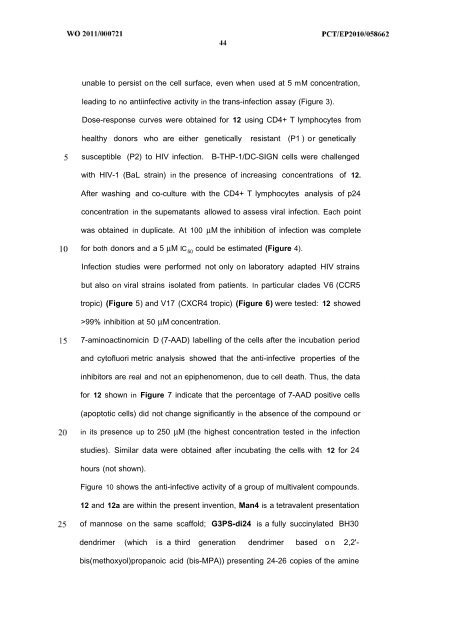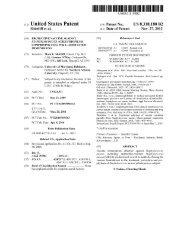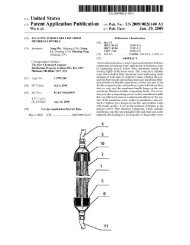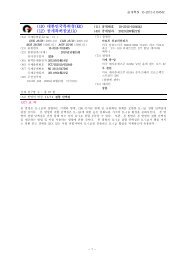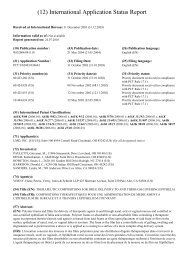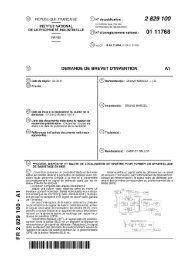W0 2011/000721 A1 I||||||||||||||||||||||||||||||||||||||||||||||||||||||||| - Questel
W0 2011/000721 A1 I||||||||||||||||||||||||||||||||||||||||||||||||||||||||| - Questel
W0 2011/000721 A1 I||||||||||||||||||||||||||||||||||||||||||||||||||||||||| - Questel
Create successful ePaper yourself
Turn your PDF publications into a flip-book with our unique Google optimized e-Paper software.
unable to persist on the cell surface, even when used at 5 mM concentration,<br />
leading to no antiinfective activity in the trans-infection assay (Figure 3).<br />
Dose-response curves were obtained for 12 using CD4+ T lymphocytes from<br />
healthy donors who are either genetically resistant (P1 ) or genetically<br />
susceptible (P2) to HIV infection. B-THP-1/DC-SIGN cells were challenged<br />
with HIV-1 (BaL strain) in the presence of increasing concentrations of 12.<br />
After washing and co-culture with the CD4+ T lymphocytes analysis of p24<br />
concentration in the supematants allowed to assess viral infection. Each point<br />
was obtained in duplicate. At 100 μM the inhibition of infection was complete<br />
for both donors and a 5 μM IC 50 could be estimated (Figure 4).<br />
Infection studies were performed not only on laboratory adapted HIV strains<br />
but also on viral strains isolated from patients. In particular clades V6 (CCR5<br />
tropic) (Figure 5) and V17 (CXCR4 tropic) (Figure 6) were tested: 12 showed<br />
>99% inhibition at 50 μM concentration.<br />
7-aminoactinomicin D (7-AAD) labelling of the cells after the incubation period<br />
and cytofluori metric analysis showed that the anti-infective properties of the<br />
inhibitors are real and not an epiphenomenon, due to cell death. Thus, the data<br />
for 12 shown in Figure 7 indicate that the percentage of 7-AAD positive cells<br />
(apoptotic cells) did not change significantly in the absence of the compound or<br />
in its presence up to 250 μM (the highest concentration tested in the infection<br />
studies). Similar data were obtained after incubating the cells with 12 for 24<br />
hours (not shown).<br />
Figure 10 shows the anti-infective activity of a group of multivalent compounds.<br />
12 and 12a are within the present invention, Man4 is a tetravalent presentation<br />
of mannose on the same scaffold; G3PS-di24 is a fully succinylated BH30<br />
dendrimer (which is a third generation dendrimer based o n 2,2'-<br />
bis(methoxyol)propanoic acid (bis-MPA)) presenting 24-26 copies of the amine


